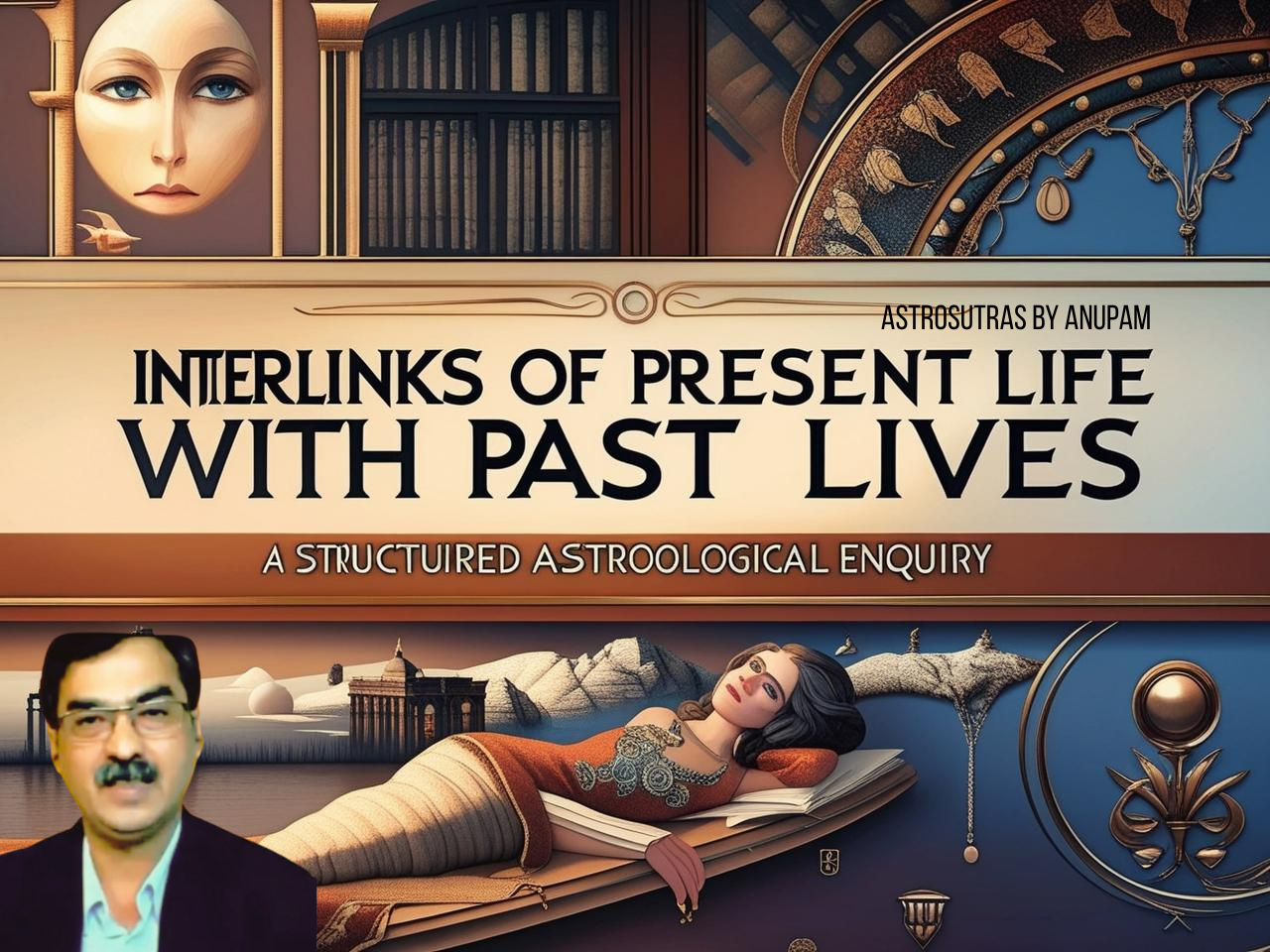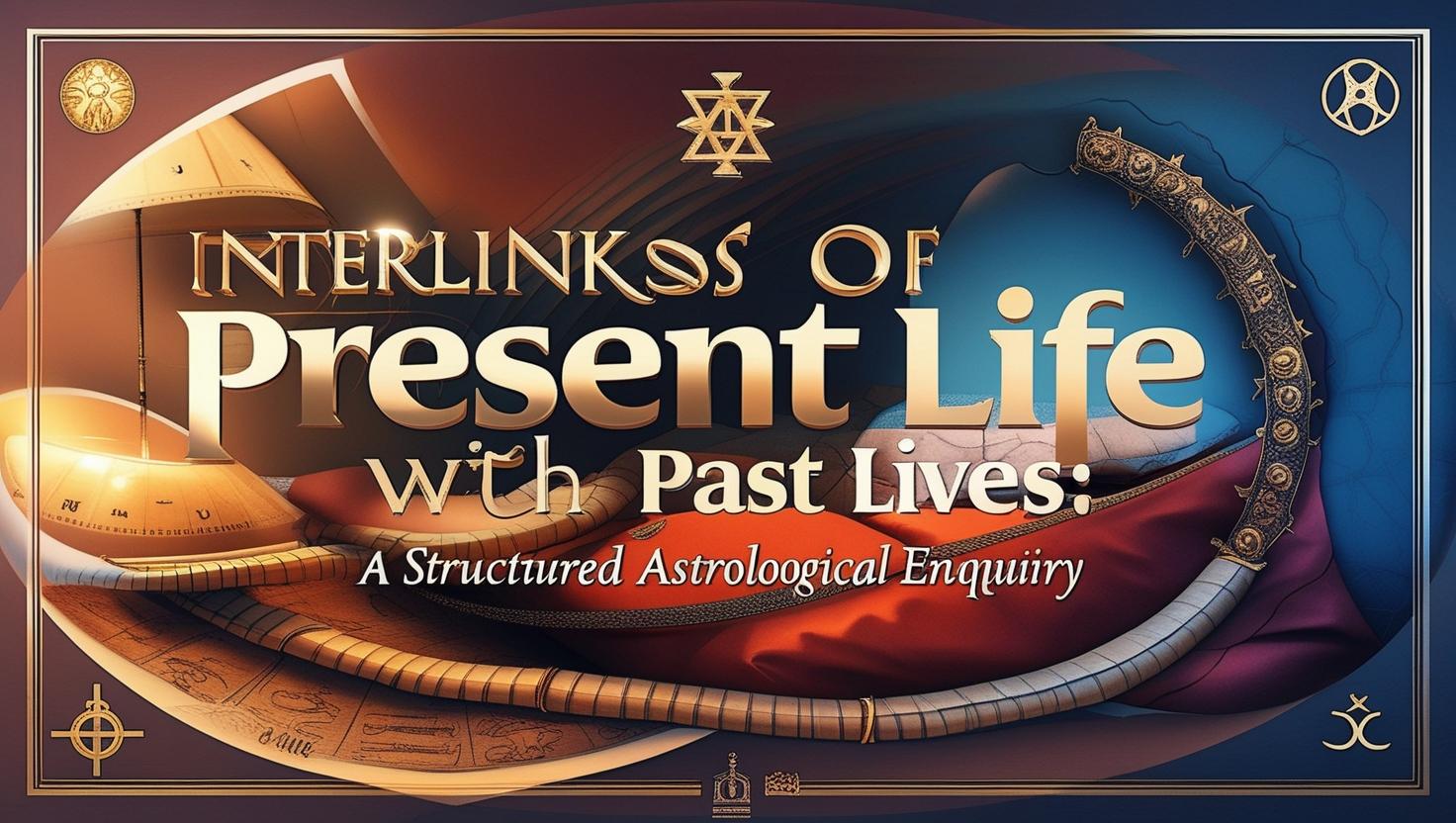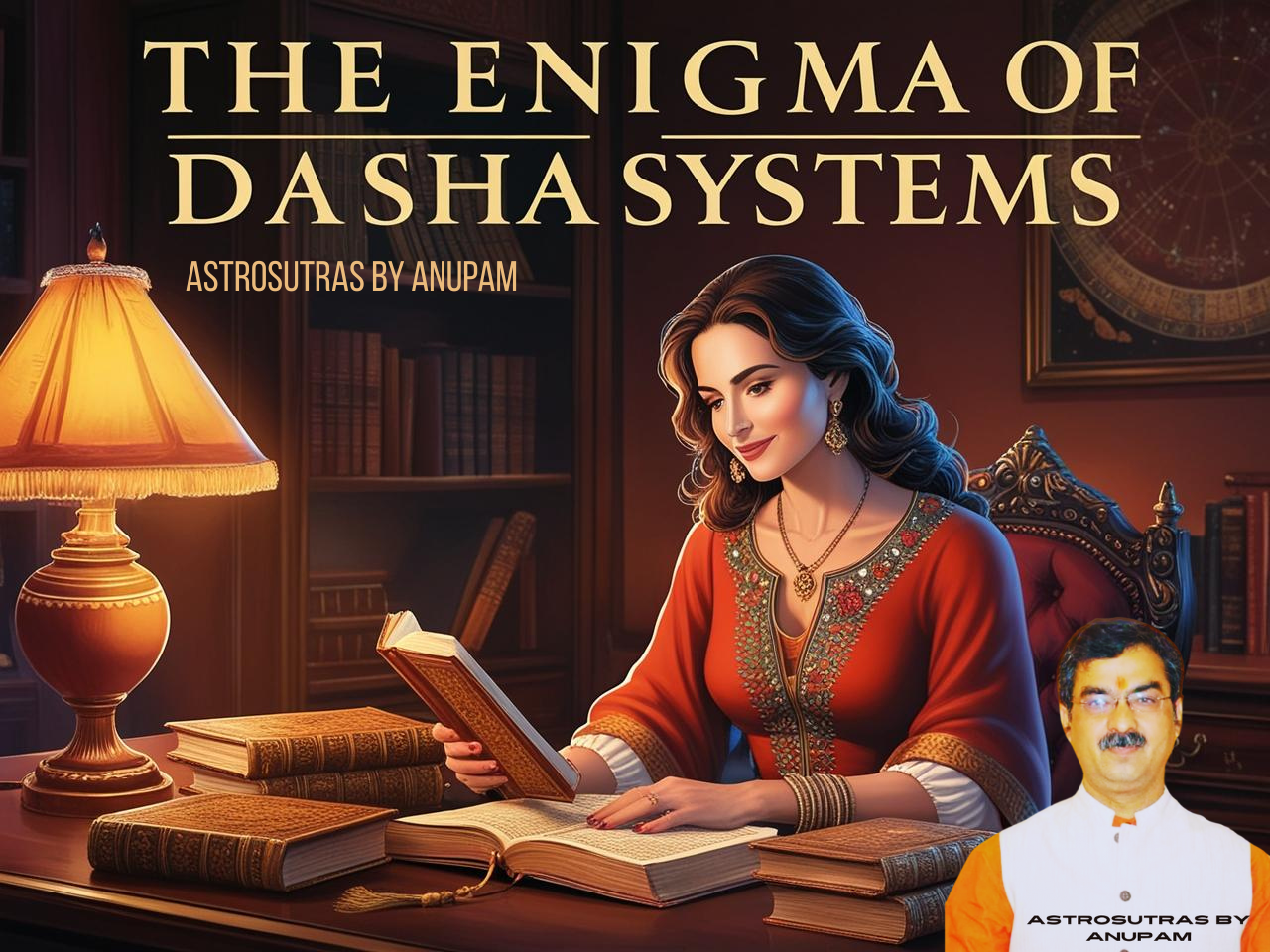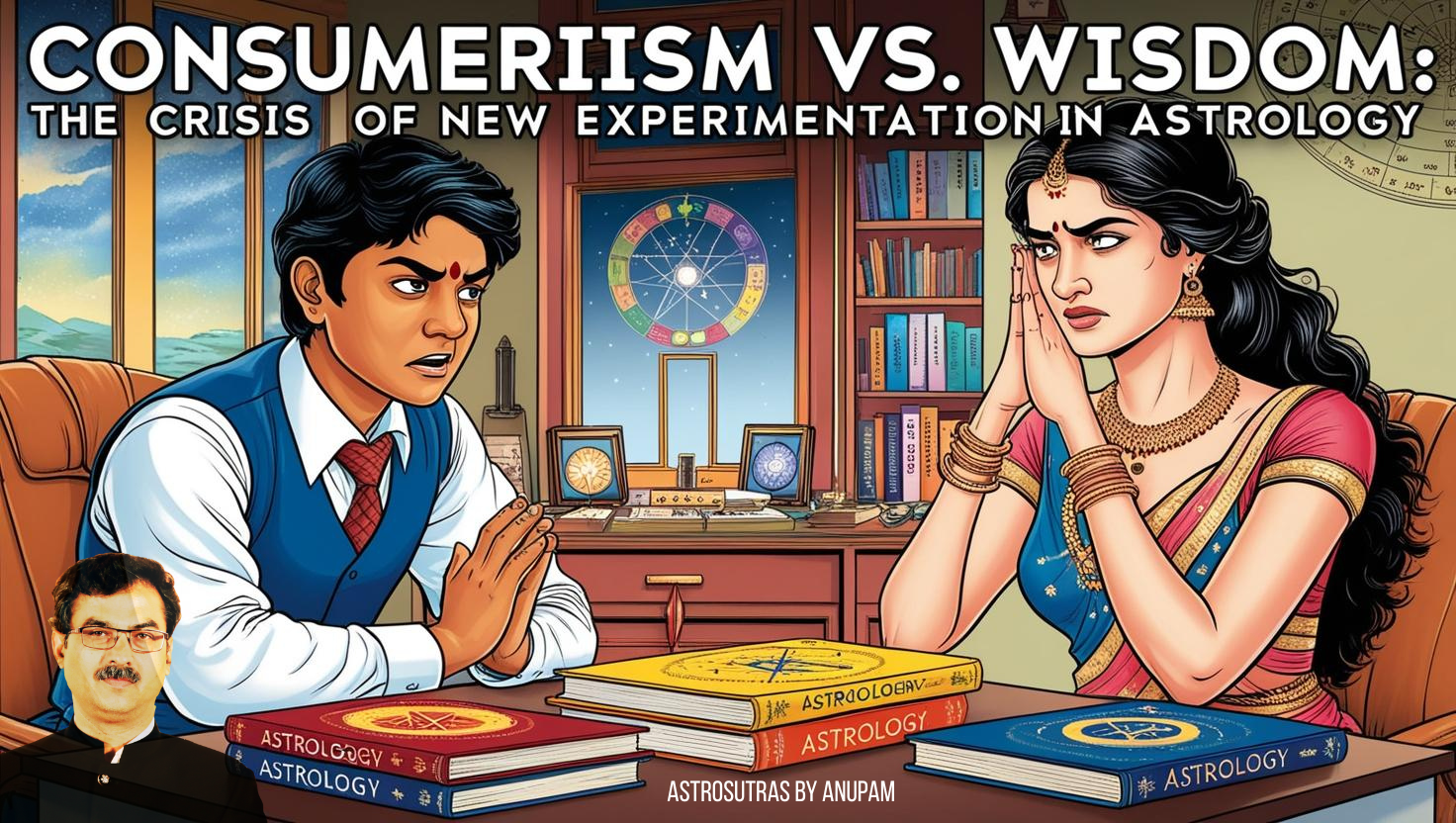“Retracing Threads of Interlinks of Present Life with Past Lives”:

Retracing Threads of Interlinks of Present Life with Past Lives: A Structured Astrological Enquiry
In the pursuit of understanding the deeper intricacies of human life through the lens of Vedic astrology, one cannot avoid encountering the subtle yet powerful idea of karmic continuity — the notion that our present life is neither isolated nor random, but instead, intricately interwoven with previous incarnations. However, any such inquiry must be stripped of what may be termed “mythological excesses” — symbolic narratives which, while culturally rich, may obstruct clear reasoning when employed dogmatically. Instead, the subject demands a contemplative, logic-based, and spiritually informed framework — a framework sensitive to the mystery of the supraconscious domain which, by its very nature, remains inaccessible to most ordinary minds.
The supraconscious, which drafts the script of individual life trajectories, lies far beyond the intellectual grasp of the modern individual. Only great seers and spiritually advanced beings, often those who walked the path of renunciation rather than material acquisition, are believed to have gained fleeting glimpses into this realm. This distinction is crucial, especially in contrast to the self-styled “modern seers” whose interpretations, driven more by material goals or personal recognition, may dilute the sanctity and integrity of karmic insight.
Let us now proceed step-by-step into the essential philosophical and astrological components that build the framework for understanding the interconnection between past lives and present experiences.
1. Cycle of Birth, Death, and Rebirth
Any genuine discourse on past life connection must begin with the fundamental acceptance of reincarnation — the cyclical process of birth, death, and rebirth (samsara). This cycle is driven by karma — the sum total of one’s actions, intentions, and unresolved desires. The birth chart (Janma Kundali) is a reflection of the karmic imprint brought forward from prior existences. Thus, it is not merely a predictive tool, but a karmic map meant to facilitate self-realization through worldly experiences.

2. The Environmental Echoes of Past Lives
Our present circumstances — family, society, opportunities, obstacles, and even the psychological inclinations — are not random. They are subtle echoes from past lives. The environment into which one is born acts like a bridge, carrying forward unresolved themes. For instance, patterns in relationships or repeated failures might be karmic residues demanding resolution in the current life. These traces, while not always overtly visible, are often inferred through deeply symbolic astrological signatures.
3. Absence of Direct Clarity in Core Texts
It must be acknowledged that classical texts do not always offer explicit, structured teachings on past-life connections. Instead, they are embedded in allegories, esoteric language, or devotional expressions. Puranic literature, for example, often portrays karmic debts through narratives of curses or boons, which may seem ornamental or dramatic. But these metaphors must be interpreted not literally, but philosophically, indicating deeper psychological or energetic truths.
4. Karmic Theory in Puranic Literature and Its Testing
While the Puranas and Karm Vipak Granthas offer descriptions of past-life consequences, these must not be accepted as gospel without scrutiny. Instead, one must test them through empirical tools available today, such as past-life regression therapy, introspective yogic practices, or deep astrological analysis using higher divisional charts like the D60 (Shashtiamsa). Spiritual texts serve as guiding beacons, but experiential verification is essential in our rational age.
5. Prarabdha, Sanchit, and Free Will: Clarifying the Karmic Triad
Understanding the threefold division of karma is essential:
- Sanchit Karma: The entire accumulated karmic stockpile from countless lifetimes.
- Prarabdha Karma: That specific portion of Sanchit karma chosen to be experienced in the current life.
- Kriyamana Karma (Free Will): The new karma created through present choices and actions.
Astrology primarily deals with Prarabdha, the ‘destined’ portion. However, it also hints at zones where free will can intervene, especially through Upachaya houses (3rd, 6th, 10th, 11th) where effort and initiative can rewrite destiny.
6. Difference Between Chaitya and Aatma (Soul)
In spiritual philosophy, Aatma is the eternal, unchanging self — the divine consciousness beyond the reach of karma. Chaitya Purusha, on the other hand, is the indwelling psychic being — the evolving aspect of the soul that carries forward impressions, learns from each life, and seeks divine union. In astrological terms, the Moon is often seen as representing the Chaitya, while the Sun symbolizes the divine essence (Aatma). Understanding this distinction helps us perceive how karma acts on the evolving soul, not on the Aatma which remains untouched.
7. Tanmatras and Their Astrological Understanding
Tanmatras refer to the subtle elements — sound, touch, form, taste, and smell — that compose sensory experience. In astrology, these can be loosely correlated with planetary energies: Jupiter governs knowledge (sound), Venus governs taste and smell, Mars governs touch, etc. These subtle tendencies are also karmically inherited, and deep study into Tanmatra-level instincts can reveal past-life triggers. These impulses can be mapped through planetary afflictions, avasthas, and varga imbalances.
8. Sixth House and the Role of Shadripus
The 6th house in a birth chart indicates enemies, disease, debts, and service — but more subtly, it reveals the karmic challenges from the past that must be addressed in the current life. It is deeply connected with the Shadripus — the six enemies of the soul: kama (lust), krodha (anger), lobha (greed), moha (attachment), mada (ego), matsarya (jealousy). Affliction in this house or its lord, particularly from malefics like Mars and Rahu, may signify unresolved karmas involving these vices.
9. The Mysterious Eighth House
The 8th house is the doorway to the unknown, transformation, death, and the occult. It often hides clues to sudden karmic returns and traumas carried over from previous lives. It is the repository of latent experiences—those that must be brought into consciousness through events like accidents, losses, or spiritual awakening. Benefic planets here may signify intuitive understanding of occult truths, while malefic combinations may suggest turbulent karmic baggage.
10. The Role of the Twelfth House
The 12th house indicates loss, liberation, foreign lands, dreams, and moksha (salvation). But more importantly, it is the exit gate of the soul. It may reveal how a soul disengaged from the previous incarnation and what residual attachments it carries. Planets here, especially Moon and Ketu, may point to past-life obsessions or unfinished desires. Its connection to the Ascendant and Moon can offer profound insights into the soul’s journey from one life to another.
The Ascendant Degree: The Cosmic Contract
The degree of the ascendant is not a random moment; it is a precise cosmic agreement marking the entry of the soul into material life. This point may conceal the soul’s intention — what it wishes to learn, redeem, or resolve. Houses impacted by this degree — especially those holding dusthanas (6th, 8th, 12th) or being occupied by nodes and Saturn — may reveal deeply embedded karmic objectives.
Revisiting Trines, Kendras, Dusthanas, and the Role of the Nodes and Saturn
Traditional house groupings — Trines (1st, 5th, 9th), Kendras (1st, 4th, 7th, 10th), Upachayas, and Dusthanas — must be re-interpreted through the lens of karmic progression. Trines may show the soul’s accumulated virtue, Dusthanas its unresolved debt, and Kendras its platform for action. Rahu and Ketu, along with Saturn, become the primary karmic indicators. Their placement and affliction or association with Sun, Moon, and Lagna reveal crucial narratives of past-life entanglements and present-life struggles.
Family, Society, and Past-Life Links: The Second and Seventh Houses
The 2nd house, representing family and lineage, may show karmic ties from the past — especially unfulfilled responsibilities or inherited patterns. Similarly, the 7th house, as the house of relationships and social interaction, is where the native must face the external world directly. Here, karmic contracts often play out — especially if influenced by Venus, Ketu, or afflicted Mars. The battlefield of marriage or partnerships may very well be the crucible for karmic testing.
The Role of Higher Divisionals: D27, D30, D40, D45, and D60
To explore these layers of karmic entanglement, higher divisional charts are essential:
- D27 (Saptavimshaamsha) reveals strengths and weaknesses in the soul’s faculties.
- D30 (Trimsamsha) decodes evil tendencies and psychological karma.
- D40 and D45 show matrilineal and patrilineal karmas.
- D60 (Shashtiamsa) is the final ledger of karma — where past-life signatures are fully encoded.
Yes, exact birth time is critical. But if life is pre-orchestrated, and if divine intelligence arranges birth conditions, then even astrological access to these charts may be a part of that divine design.
The Exploitation of Past-Life Astrology: A Word of Caution
With the rise of commercial astrology, past-life readings have become a trendy offering — often romanticized or fear-driven, appealing to vulnerable clients. Karm Vipak stories, while powerful, have often become instruments of fear and monetization. Such misappropriation must be checked by ethical standards and genuine spiritual intent. It is not about exploiting a seeker’s curiosity, but about helping them understand, heal, and grow.
The Role of Meditation and Spiritual Practice
Techniques like Kriya Yoga, the teachings of Sri Aurobindo, and various forms of meditative self-inquiry provide non-astrological pathways to trace and purify past-life imprints. Astrology is not the only lens; it is one among many. Integrating spiritual disciplines with astrological understanding can lead to true inner transformation.
Conclusion: A Call for Responsible Karmic Astrology
As the demand for karmic astrology rises, masters of astrology must rise to the occasion. The innocent client, often unaware of the complexity of karma, must be protected from sensationalism and guided toward self-awareness and practical action. Past-life astrology should not become a gimmick. It should serve as a tool of soulful healing, ethical living, and karmic completion.
To be continued…

